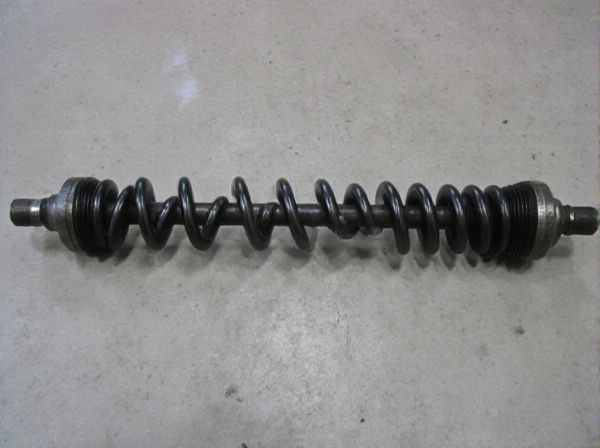
Photo illustration: Spline Driveshaft vs Non-spline Driveshaft
Spline driveshafts offer enhanced torque transmission and improved alignment due to their interlocking ridges, reducing the risk of slipping under heavy loads. Non-spline driveshafts typically rely on simpler connections and may experience more wear or misalignment in demanding applications. Choosing a spline driveshaft can optimize your vehicle's performance and durability, especially in high-stress environments.
Table of Comparison
| Feature | Spline Driveshaft | Non-spline Driveshaft |
|---|---|---|
| Design | Multiple grooves (splines) for torque transfer | Smooth shaft without grooves |
| Torque Transmission | High efficiency, secure fit | Lower torque capacity |
| Flexibility | Allows axial movement and alignment | Limited or no axial movement |
| Durability | Better wear resistance due to load distribution | More prone to wear and damage |
| Cost | Higher manufacturing cost | Lower cost, simpler design |
| Common Use | Performance and heavy-duty vehicles | Standard, economy vehicles |
Introduction to Driveshafts
Driveshafts are critical components in vehicle drivetrains, transmitting torque from the engine to the wheels. Spline driveshafts feature interlocking ridges or grooves that allow for axial movement and precise torque transfer, enhancing flexibility and durability in dynamic driving conditions. Non-spline driveshafts use fixed connections, which may limit adjustability but provide simplicity and cost-effectiveness for less demanding applications.
What is a Spline Driveshaft?
A spline driveshaft features multiple grooves or teeth along its shaft that interlock with corresponding grooves in the mating component, allowing for efficient torque transfer and axial movement. This design reduces the risk of slippage and ensures precise alignment between the driveshaft and other drivetrain parts. In contrast, non-spline driveshafts lack these grooves, often relying on simpler attachment methods that may not provide the same level of mechanical engagement or flexibility during rotational movement.
What is a Non-spline Driveshaft?
A non-spline driveshaft is a type of driveshaft that lacks the interlocking ridges or grooves found on spline driveshafts, relying instead on other connection methods such as a plain shaft with a fixed yoke or flange attachment. This design typically results in simpler manufacturing and maintenance but can offer less flexibility in length adjustment and may not handle torque transmission as efficiently as spline driveshafts. Non-spline driveshafts are commonly used in older or less performance-intensive vehicles where high precision and adaptability are less critical.
Key Differences Between Spline and Non-spline Driveshafts
Spline driveshafts feature multiple grooves or teeth that interlock precisely with mating components, allowing for efficient torque transmission and axial movement accommodation under load. Non-spline driveshafts rely on simpler, often cylindrical shafts secured by keys or pins, offering less flexibility in handling axial displacement and generally lower torque capacity. The key differences lie in the spline's ability to maintain alignment and absorb stress through interlocking grooves versus the non-spline's more limited engagement and potential for slippage under high torque conditions.
Advantages of Spline Driveshafts
Spline driveshafts offer enhanced torque transmission efficiency due to their interlocking teeth design, which reduces slippage and increases mechanical engagement compared to non-spline driveshafts. They provide superior alignment and load distribution, resulting in increased durability and reduced wear under high-stress conditions. Maintenance is simplified with spline driveshafts as they allow easy length adjustments without disassembly, improving overall vehicle drivetrain performance.
Advantages of Non-spline Driveshafts
Non-spline driveshafts offer enhanced durability due to their solid shaft design, reducing wear and tear under heavy torque loads. They provide simpler maintenance with fewer moving parts, resulting in lower long-term repair costs and increased reliability. Their rigidity improves power transfer efficiency, minimizing vibration and torsional fatigue compared to spline driveshafts.
Applications: When to Use Each Type
Spline driveshafts excel in applications requiring precise torque transmission and axial movement, such as high-performance vehicles, off-road machinery, and heavy-duty trucks where flexibility and strength are critical. Non-spline driveshafts suit simpler, low-torque applications like standard passenger cars or light-duty equipment where cost-effectiveness and ease of maintenance are prioritized. Selecting between spline and non-spline driveshafts depends on load demands, mechanical stress tolerance, and movement requirements within the drive system.
Durability and Maintenance Comparison
Spline driveshafts offer enhanced durability due to their ability to accommodate axial movement and torque variations, reducing wear on universal joints and preventing premature failure. Non-spline driveshafts typically experience higher stress concentrations at connection points, leading to increased maintenance requirements and potential for faster degradation. Maintenance for spline driveshafts is generally less frequent and less intensive, as their design facilitates better alignment and load distribution compared to non-spline alternatives.
Performance Impact: Spline vs Non-spline
Spline driveshafts offer enhanced torque transmission and improved alignment due to their interlocking ridges, resulting in reduced vibration and increased durability compared to non-spline driveshafts. Non-spline driveshafts, relying on simpler connections, may experience more play and decreased precision under high-performance conditions, potentially leading to quicker wear and less efficient power transfer. Choosing spline over non-spline driveshafts significantly impacts vehicle performance by ensuring smoother power delivery and extended component life.
Conclusion: Choosing the Right Driveshaft for Your Needs
Spline driveshafts offer superior torque transfer and flexibility due to their interlocking teeth design, making them ideal for high-performance and off-road applications. Non-spline driveshafts, typically simpler and cost-effective, suit standard driving conditions with less demand for precision and torque capacity. Selecting the right driveshaft depends on your vehicle's performance requirements, driving environment, and budget constraints, ensuring optimal durability and efficiency.
 caratoz.com
caratoz.com